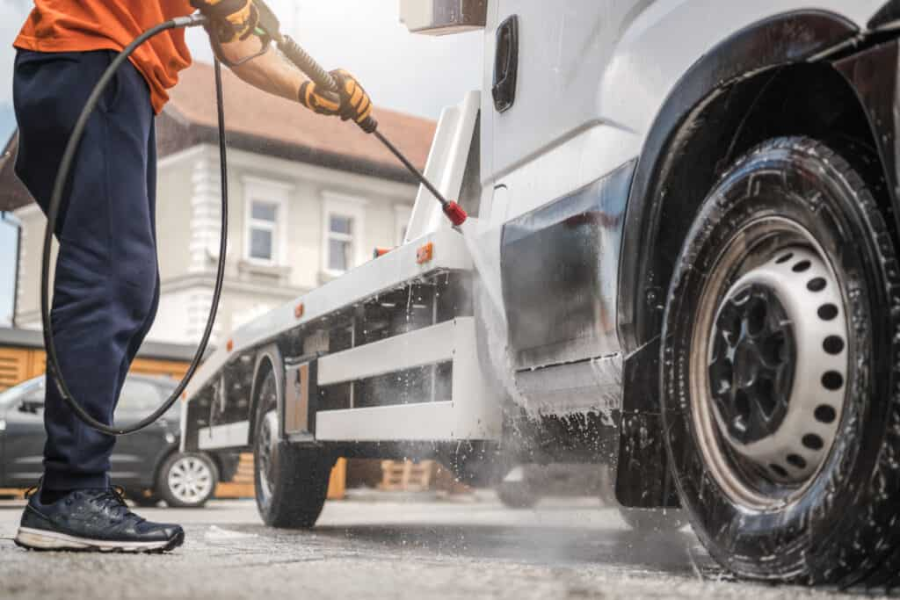Let’s face it, Karen from accounting wouldn’t be too thrilled if her shiny new delivery van returned from its first route looking like it went ten rounds with a mud monster. A fleet covered in grime isn’t exactly sending the best message to your customers, either. But keeping a large fleet clean, especially when your vehicles are scattered across different locations, can feel like trying to polish a mountain – a never-ending, thankless task.
Fear not, weary fleet manager! There’s a secret weapon in your arsenal that can transform your fleet from drab to fab, and it offers way more benefits than just a sparkling appearance. We’re talking about the mighty pressure washer, and it’s about to become your new best friend.
Clean Fleet, Big Impact: Why Presentation Matters
A clean fleet isn’t just about vanity (although let’s be honest, a sparkling truck does look pretty darn good). It shows your customers that you take pride in your business and that you care about the details. Think about it: when you see a clean, well-maintained vehicle, it reflects positively on the entire company. It creates a professional image, and that can go a long way in boosting your brand reputation. Imagine the difference between a customer flagging down a dusty, dented van with peeling paint, versus a spotless, sleek vehicle that looks ready to tackle any delivery challenge. The clean truck instantly creates a more positive first impression, right?
Safety First: Clean Equals Clear Vision
Pressure washing removes dirt, grime, and grease that can build up on your vehicles over time. This not only improves the aesthetics of your fleet, but it also enhances driver safety in a big way. By removing grime from windshields and windows, you’re giving your drivers a clear view of the road, reducing the risk of accidents. Think about it: how comfortable would you feel driving a car with a windshield so caked in mud you could barely see out? Not very, right? A clean windshield allows drivers to focus on the road, anticipate hazards, and react quickly in any situation.
Pressure washing also helps you identify potential problems early on. A clean undercarriage makes it easier to spot leaks or signs of wear and tear on essential components. Catching these issues early can save you a ton of money and hassle down the road (pun intended!). Imagine the cost difference between a small oil leak you fix right away, versus a major engine failure caused by a neglected leak. Yikes!
Keeping it Healthy: A Clean Ride for Everyone
Let’s not forget about hygiene! Pressure washing helps eliminate dirt, bacteria, and allergens that can accumulate on your vehicles, especially those used for public transportation or food delivery. These tiny buggers love to hitch a ride on dirty surfaces, and let’s be honest, nobody wants a surprise case of the sniffles after hopping on a grimy bus. By creating a cleaner environment for both passengers and drivers, you’re helping to prevent the spread of germs and keep everyone healthy. This is especially important in today’s world, where hygiene is a top priority.
Power Up Your Cleaning Arsenal: Choosing the Right Tools
Now that you’re convinced a clean fleet is a must-have, let’s talk about the tools you need to get the job done.
Gas-Powered Pressure Washers: Pack a Punch for Commercial Fleets
For commercial vehicles, electric pressure washers just won’t cut it. They might be great for cleaning your patio furniture, but they lack the cleaning power needed to tackle the heavy-duty grime that builds up on trucks, buses, and vans. That’s why gas-powered pressure washers are the way to go. They offer higher PSI (pounds per square inch) –, more cleaning power – which means you can clean your fleet faster and more efficiently.
Choosing the Right PSI: Not All Power Washers Are Created Equal
But wait, there’s more to the story than just picking the most powerful pressure washer you can find. The PSI of your pressure washer matters. Too much power can damage your vehicles, while too little won’t be effective at removing stubborn dirt. So, what’s the magic number? Here’s a general guideline:
- 1,500-2,000 PSI: This range is suitable for light cleaning tasks on cars, vans, and trailers.
- 2,000-3,000 PSI: This is the sweet spot for most commercial vehicles. It offers enough power to remove tough grime without damaging paint or delicate surfaces.
- 3,000+ PSI: This is for heavy-duty cleaning tasks on industrial vehicles or heavily soiled fleets. Be extra cautious when using a high-PSI pressure washer, as it can easily damage paintwork or strip away protective coatings.
Essential Extras for a Flawless Finish: Beyond the Pressure Washer
No pressure washing job is complete without the right accessories. Here are a few must-haves to elevate your fleet cleaning game:
- Variety of Nozzle Attachments: Different tasks require different cleaning approaches. Having a variety of nozzle attachments will allow you to tackle any cleaning challenge. Here’s a quick rundown:
- Wide fan nozzle: Perfect for general cleaning of large areas like vehicle sides.
- Rotating nozzle: Ideal for removing stubborn grime and caked-on dirt.
- Soap nozzle: Allows you to easily apply cleaning solution during the pre-soak stage.
- Undercarriage nozzle: Designed to clean those hard-to-reach areas beneath the vehicle.
- Hoses: Ensure you have durable, high-quality pressure washing hoses that can handle the pressure and provide flexibility during cleaning.
- Detergent Tank: Using a dedicated cleaning solution with your pressure washer will give your vehicles an extra sparkle. Choose a high-quality detergent specifically formulated for commercial vehicles to remove dirt, grime, and grease effectively.
Pressure Washing Trailers: Clean on the Go!
For companies with geographically dispersed fleets or limited workspace at their depots, pressure-washing trailers are a game-changer. These self-contained units are mobile pressure washing stations on wheels. They come equipped with onboard water tanks and fuel supplies, eliminating the need to worry about finding an external water source or lugging around hoses and buckets. Plus, they’re mobile, allowing you to clean your vehicles on-site, saving you time and resources compared to transporting them back to a central depot for washing.
Here are some additional benefits of pressure washing trailers:
- Industrial-Grade Power: Some pressure washing trailers offer industrial-grade pressure washers that can handle even the toughest grime on heavy-duty vehicles, like construction trucks or tankers.
- Increased Efficiency: No more waiting in line at a car wash or wasting time transporting vehicles back and forth. Pressure washing trailers allow you to clean your fleet quickly and efficiently, minimizing downtime.
- Dedicated Work Areas: Many pressure washing trailers come with designated work areas that provide a safe and organized space for cleaning your vehicles.
Choosing the Right Trailer: Finding the Perfect Fit
When selecting a pressure washing trailer setup for sale, consider these factors:
- Water Tank Capacity: This determines how many vehicles you can clean before refilling. Trailers come in various sizes with different water tank capacities. Choose one that suits your fleet size and cleaning frequency.
- Fuel Efficiency: You want a trailer that gets the job done without guzzling gas. Look for models with fuel-efficient engines to minimize operating costs.
- Trailer Size and Maneuverability: Make sure the trailer can navigate tight spaces or uneven terrain where your vehicles might be parked. Consider the width, height, and turning radius of the trailer to ensure it can access all cleaning locations.
Safety First, Shine Always!
Before you start pressure washing, safety is key! Here are some essential safety tips to remember:
- Protective Gear: Always wear proper personal protective equipment (PPE) when pressure washing. This includes safety glasses, gloves, and closed-toe shoes. The high water pressure can cause serious injury if not handled properly.
- Pressure Washing Trailer Safety Features: Many pressure washing trailers come equipped with safety features like pressure control valves and automatic shut-off mechanisms. Familiarize yourself with these features before operating the trailer.
- Work Area Preparation: Ensure your cleaning area is free of debris and obstacles. Avoid pressure washing near electrical outlets or open flames.
- Maintaining a Safe Distance: Keep the pressure washer nozzle at a safe distance from the vehicle you’re cleaning. Refer to the manufacturer’s instructions for the recommended distance for different cleaning tasks and nozzle attachments.
Step-by-Step to a Sparkling Fleet: A Beginner’s Guide
Now that you’re armed with the right tools and knowledge, let’s get down to the nitty-gritty of the commercial cleaning fleet. Here’s a step-by-step guide to help you achieve a sparkling clean:
- Pre-Soak: The first step is to apply a pre-soak solution to loosen dirt and grime. This will make it easier to remove during the pressure washing stage. Use a dedicated soap nozzle with your pressure washer to apply the cleaning solution evenly over the entire vehicle.
- Low-Pressure Rinse: Before cranking up the pressure, use a low-pressure setting to remove loose dirt, debris, and the pre-soak solution.
- Targeted Cleaning: This is where the different nozzle attachments come into play. Use a wide fan nozzle for general cleaning of large areas like the vehicle sides and hood. For stubborn grime and caked-on dirt, switch to a rotating nozzle. Don’t forget the undercarriage! Use a dedicated undercarriage nozzle to clean those hard-to-reach areas beneath the vehicle. Pay close attention to the wheel wells and fenders, as these areas tend to accumulate a lot of dirt and grime.
Pro Tip: Start from the top of the vehicle and work your way down to avoid streaking.
- Final Rinse: Once you’ve tackled all the dirty areas, use a low-pressure setting to give your vehicle a final rinse. This will remove any remaining soap residue and ensure a spotless finish.
For the Tough Jobs: Advanced Techniques
For heavily soiled vehicles that have been neglected for a while, you might consider some advanced techniques:
- Steam Cleaning: Steam cleaning is a powerful tool for tackling stubborn grime, grease, and even chewing gum stuck on the vehicle. It uses high-temperature steam to break down dirt and grime without damaging delicate surfaces. However, steam cleaning requires specialized commercial cleaning equipment and training. If you’re a pressure-washing newbie, it’s best to leave this technique to the professionals.
- Degreaser Attachments: Degreaser attachments can be a lifesaver for removing stubborn oil and grease build-up, especially on heavily used vehicles or those involved in construction or food service. However, degreasers are potent chemicals and require careful handling. Always wear proper PPE when using degreasers, and be sure to follow the manufacturer’s instructions for safe and effective use.
Maintaining the Shine: Keeping Your Fleet Looking Its Best
Now that your fleet is sparkling clean, the key is to maintain that shine. Here are some tips:
- Regular Pressure Washing Schedule: The frequency of pressure washing will depend on several factors, such as the type of vehicle, the operating environment, and your chosen cleaning method (stationary pressure washer vs. pressure washing trailer). For heavily used vehicles in dusty or dirty environments, you might need to pressure wash them weekly or bi-weekly. Less frequently used vehicles in cleaner environments can be washed on a monthly or bi-monthly basis.
- Spot Cleaning in Between Washes: Throughout the month, minor dirt build-up can occur. To maintain a clean appearance, address these minor issues with spot cleaning. Use a garden hose and a mild cleaning solution to tackle small areas of dirt before they turn into bigger problems.
- Post-Wash Inspection: After pressure washing your vehicles, take a moment to inspect them for any potential damage. The high water pressure can sometimes reveal existing cracks or loose paint that may need attention. Addressing these issues early can prevent them from becoming bigger problems down the road.
The Power of a Clean Fleet: The Big Picture
By incorporating pressure washing into your fleet maintenance routine, you’re not just making your vehicles look good, you’re reaping a multitude of benefits:
- Professional Image and Brand Reputation: A clean fleet reflects a professional and well-maintained business, fostering trust and confidence with your customers.
- Enhanced Driver Safety: Removing dirt, grime, and grease from windshields and windows improves driver visibility, reducing the risk of accidents. A clean undercarriage also helps with the early detection of potential leaks or mechanical issues.
- Improved Hygiene for a Healthier Environment: Pressure washing helps eliminate dirt, bacteria, and allergens that can accumulate on vehicles. This creates a cleaner environment for both passengers and drivers, preventing the spread of germs and promoting overall health.
- Increased Efficiency, Especially for Geographically Dispersed Fleets: Pressure washing trailers allow for on-site cleaning, eliminating the need to transport vehicles back to a central depot for washing. This saves time, and resources, and keeps your fleet operating at peak efficiency.
The Final Word: Keeping Your Fleet Sparkling
Pressure washing your commercial fleet offers a wealth of benefits, from creating a positive brand image to ensuring driver safety and a healthy work environment. So, ditch the bucket and sponge, and embrace the power of pressure washing! With the right tools, knowledge, and a commitment to routine cleaning, you can keep your fleet sparkling clean and operating at its best.
Bonus: Beyond the Basics – Going Green with Pressure Washing
While pressure washing is a powerful cleaning tool, it’s important to be mindful of the environment. Here are some tips for eco-friendly pressure washing:
- Biodegradable Cleaning Solutions: Choose biodegradable detergents specifically formulated for pressure washers. These detergents are just as effective at cleaning, but they break down naturally and won’t harm the environment.
- Water Conservation Techniques: Use a low-pressure setting whenever possible to minimize water usage. There are also water collection systems available that can capture the runoff water from pressure washing and reuse it for irrigation or other non-potable purposes.
- Proper Disposal of Wastewater: Don’t let the dirty runoff water simply drain away. It might contain contaminants that can harm the environment. Instead, collect the wastewater in a designated container and dispose of it responsibly according to local regulations.
By following these tips, you can ensure your pressure washing practices are not only effective but also environmentally friendly.
Keeping the Conversation Going: Share Your Fleet Cleaning Tips!
We hope this comprehensive guide has empowered you to take control of your fleet cleaning routine. Do you have any pressure washing tips or tricks that you’d like to share with other fleet managers? Perhaps you have a favorite cleaning solution or a unique way to tackle stubborn grime? Let us know in the comments below! We’d love to hear from you and keep the conversation about clean fleets going.
Keep an eye for more news & updates onBiscoverTribune.Org!




